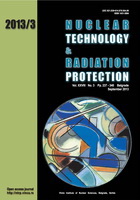
RADIOLOGICAL CHARACTERIZATION OF THE CONCRETE BIOLOGICAL SHIELD OF THE APSARA REACTOR

Vol.
XXVIII, No. 3, Pp. 237-340
September 2013
UDC 621.039+614.876:504.06
ISSN 1451-3994
Pages: 254-259
Authors: Priya Srinivasan, Panchapakesan Srinivasan, Shibu Thomas, R. K. Gopalakrishnan, A. Goswami
Abstract
The first Indian research reactor, APSARA, was utilized for various R&D programmes from 1956 until its shutdown in 2009. The biological shield of the reactor developed residual activity due to neutron irradiation during the operation of the reactor. Dose rate mapping and in-situ gamma spectrometry of the concrete structures of the reactor pool were carried out. Representative concrete samples collected from various locations were subjected to high-resolution gamma spectrometry analysis. 60Co and 152Eu were found to be the dominant gamma-emitting radionuclides in most of the locations. 133Ba was also found in some of the concrete structures. The separation of 3H from concrete was achieved using an acid digestion method and beta activity measured using liquid scintillation counting. The depth profile of radionuclide specific activity in the concrete wall of the shielding corner was also studied. Specific activities of the radionuclides were found to decrease exponentially with depth inside the concrete walls. This study would be helpful in bulk waste management during the decommissioning of the reactor.
Key words: decommissioning, bulk waste, gamma spectrometry, liquid scintillation, biological shield
FULL PAPER IN PDF FORMAT (1.15 MB)